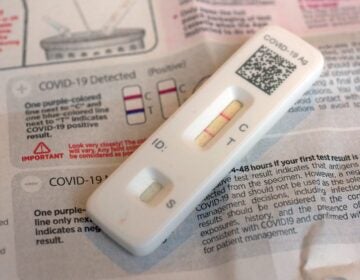How Pennsylvania fumbled COVID-19 death counts
During the deadliest months of the pandemic so far, Pa.'s new electronic reporting system wasn't ready, so it didn't have an accurate count of how many people were dying.
Listen 12:57
Pennsylvania Health Secretary Rachel Levine holds a daily briefing on COVID-19. (Commonwealth Media Services)
During the deadliest months of the pandemic so far, Pennsylvania’s new electronic death reporting system was not ready for prime time. The state still relied on faxes — yes, faxes — from funeral directors, doctors and medical examiners to create an official death record.
Sara Simon dug into the delays for Spotlight PA, along with WHYY’s Nina Feldman and Ryan Briggs. She explains that just when public officials were making tough decisions about how to allocate scarce resources, like COVID-19 tests and PPE, the state did not have an accurate count of how many people had actually died from the virus.

Hear the whole story on The Why
Interview highlights
On why Pennsylvania was slow in reporting its death count
So we need to take a step back and talk about the process of death reporting. There’s a lot of people involved here. You have a funeral director who works with the family of the deceased to input biographical information into a death certificate. You have the physician at a hospital or a nursing home who has to legally certify the cause of death. You have a coroner or a medical examiner who gets involved in cases where deaths are of a suspicious nature or of a sudden nature.
Pennsylvania’s struggle that has been years in the making, that the COVID-19 pandemic really exposed, is that there hadn’t been historically any urgency in standardizing this data reporting process. It was October 2016 that the state of Pennsylvania initially launched this new electronic death registration system. That’s four years ago. For many years, the system has been voluntary in Pennsylvania.
When the COVID-19 pandemic hit and fast, accurate, timely death reporting data had never been more important, the process was a patchwork system of people doing it different ways because that one streamlined electronic process had never been never been fully fleshed out.
On the consequences of not fully implementing the electronic system before the pandemic
What we know is that fast, accurate data can help inform decisions about where to send supplies, whether that’s PPE, where it needs to go, how to allocate resources. And having a modernized system that produces timely death information can really help efforts in protecting the living …
When we knew this pandemic was coming, the state knew that it had this system kind of half implemented … They had a decision to make: Do we mandate this … and hope for the best that people have an easy time getting to use it and hope that it will be worth it to have that faster death reporting? Or do we not?
We don’t know what the death data would have looked like if they had just decided to stick with the status flow and not implement this and not mandate the system right away. But I think what what we can say with full confidence is that originally when they launched this in 2016, the plan was to get all users fully on board and trained with this new system by the end of 2017. I think we can state with full confidence that had PA stuck to that original timeline, the delays in death reporting that we’ve seen during the COVID-19 pandemic would not have been as severe.
On why people should trust the state’s current death statistics
I have not found any evidence of any kind of malicious manipulation with these numbers. I trust the numbers that the state health department is putting out. And I think it’s really important for the public to trust these numbers, too.
WHYY is your source for fact-based, in-depth journalism and information. As a nonprofit organization, we rely on financial support from readers like you. Please give today.






